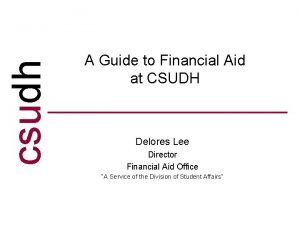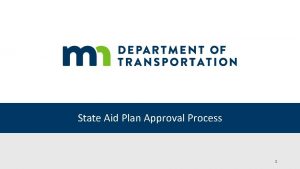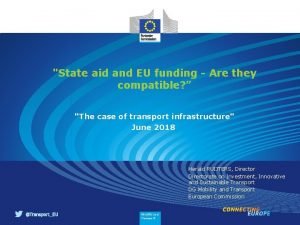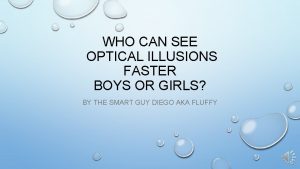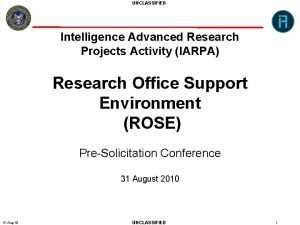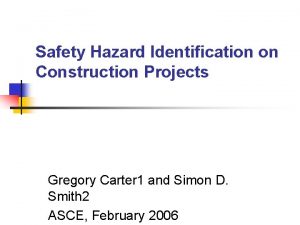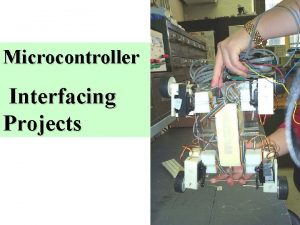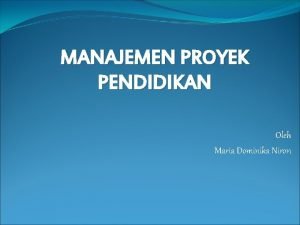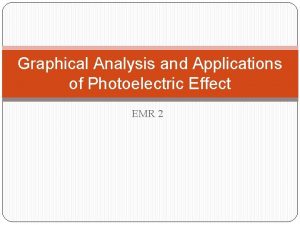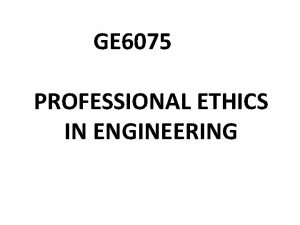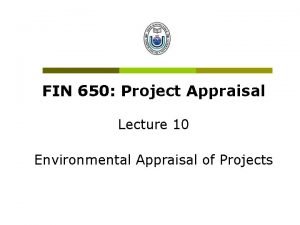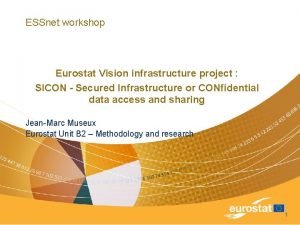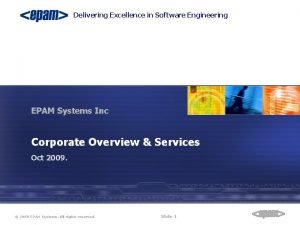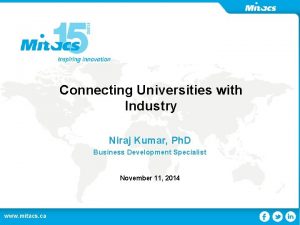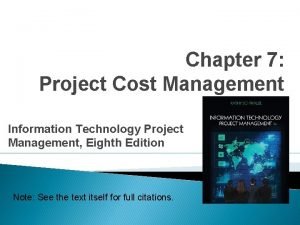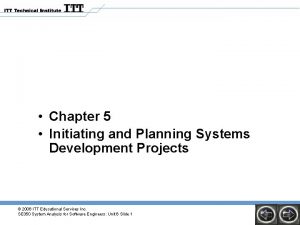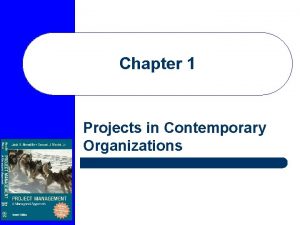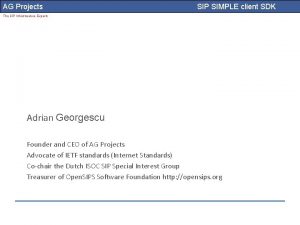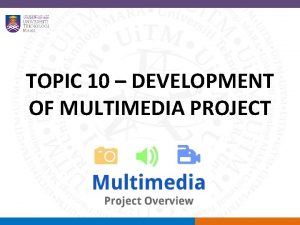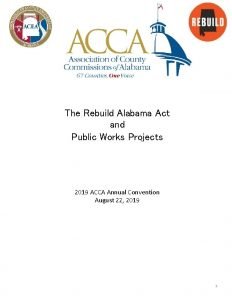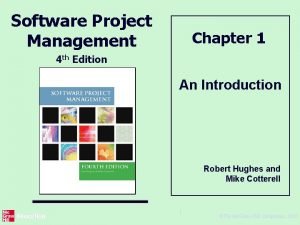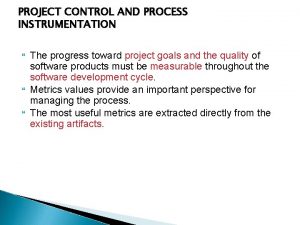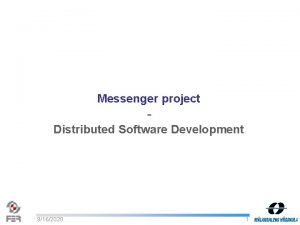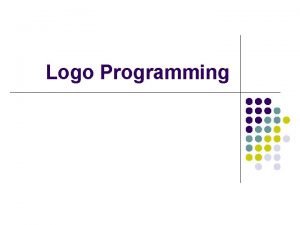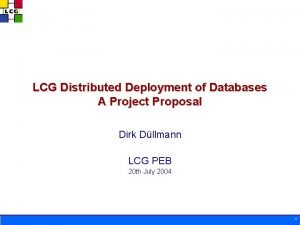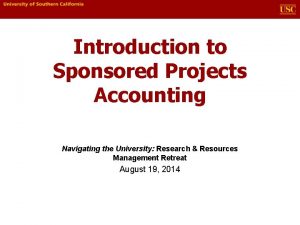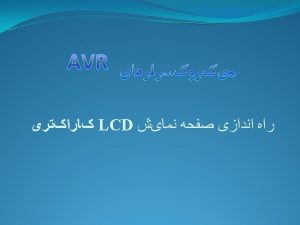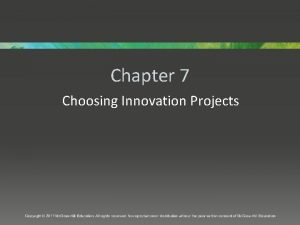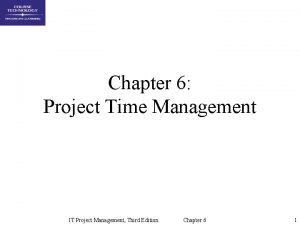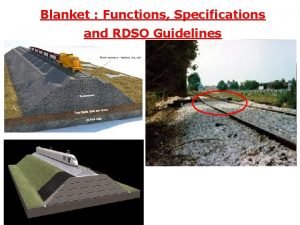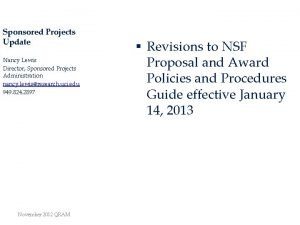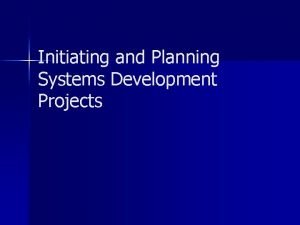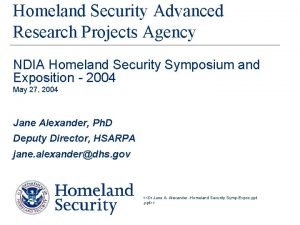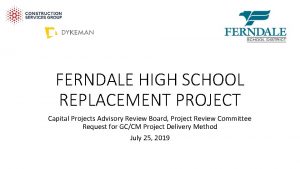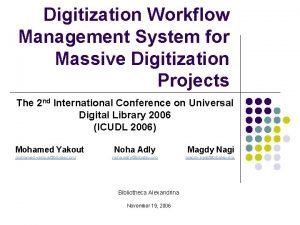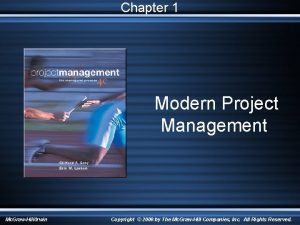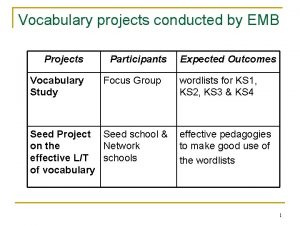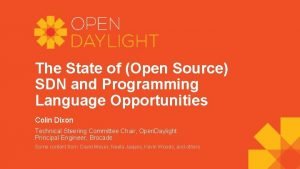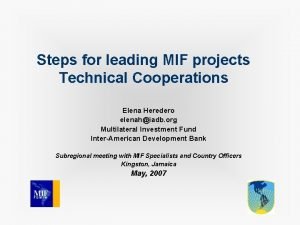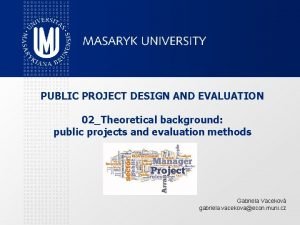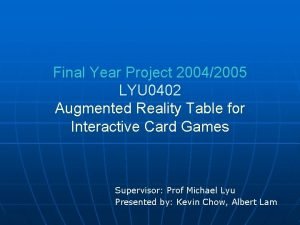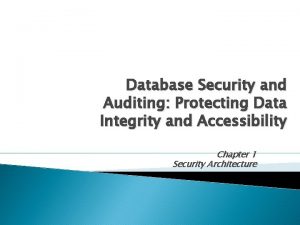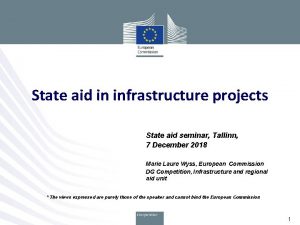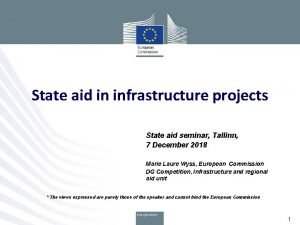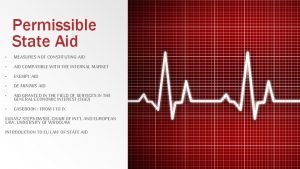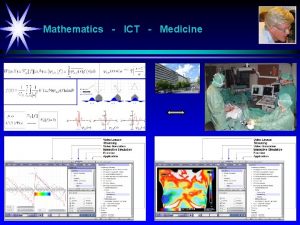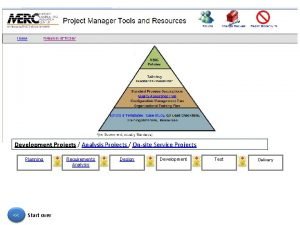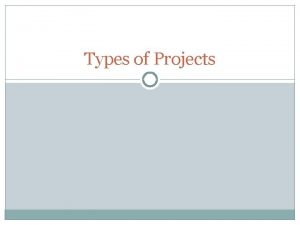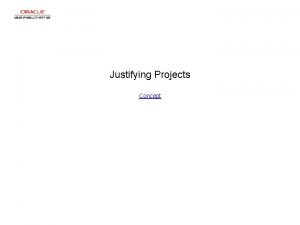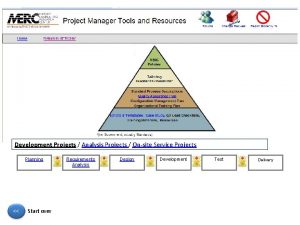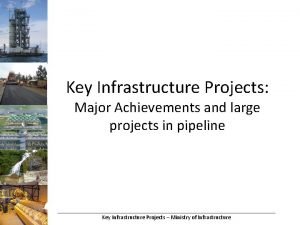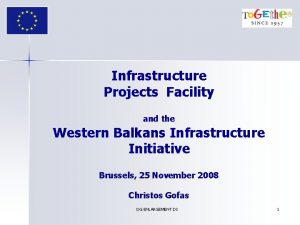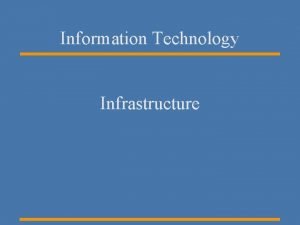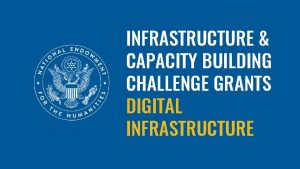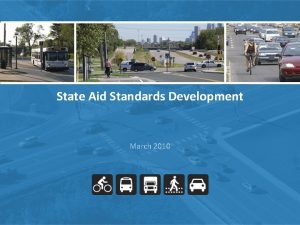State aid in infrastructure projects State aid seminar

























































































































- Slides: 121

State aid in infrastructure projects State aid seminar, Tallinn, 7 December 2018 Marie Laure Wyss, European Commission DG Competition, Infrastructure and regional aid unit * The views expressed are purely those of the speaker and cannot bind the European Commission 1

Structure of the presentation v Introduction v Notice on the Notion of State aid (No. A) v The analytical grids: v v v Culture, research Sport and multifunctional infrastructure Rail, road and water infrastructure Energy and waste management infrastructure Port, Airports, Broadband infrastructure v Conclusions 2

Background - " a change of paradigm" • The public financing of infrastructure - from "general measures of public policy" to measures subject to State aid control • Court ruling of 2000 Aéroports de Paris (T-128/98) • Court ruling of 2012 Airport Leipzig/Halle (C-288/11) • Need for clarification on how infrastructure cases should be handled with regards to State aid rules 3

Background - " Investment plan for Europe" • Promote investments in order to stimulate growth and jobs – MFF 2014 -2020 - Specific focus on infrastructure • What contribution of State aid policy in this context ? The State aid modernisation initiative (2012 ) objectives: • target market failures and objectives of common European interest, • focus on cases with the biggest impact on the internal market, • simplify and take decisions faster. 4

Background – « Investment plan for Europe » • Need for simplification and re-enforced legal certainty, for MS and managing authorities • Clarification on cases of public funding which do not entail State aid • In case there is aid, clarification of possible legal basis (Treaty, specific guidelines 107(3)c, 106 (2), GBER • For assessment of compatibility of aid in infrastructure cases, specific objectives: • Avoid harming competing projects and existing infrastructure • Avoid over-compensation (funding gap analysis) • Ensure access of different users to infrastructure 5

Background - Commission’s approach ● Revision and harmonisation of the existing rules ● GBER regulation n. 651/2014 (2014), revised in 2017 Regulation n. 2017/1084 ● Commission Notice on the Notion of aid (2016) ● Analytical grids on infrastructure 6

PART 1 - Notice on the Notion of State aid OJ EU C 262 of 19. 7. 2016 7

Objectives of the No. A • Clarify and explain the notion of State aid, as defined by article 107 (1) TFUE: easier, more transparent and more consistent application across the European Union • Summary of the interpretation of notion of State aid by the Union Courts and the Commission's own case practice • Where Union Courts' case law is not available, guidance is provided in the form of the Commission's own interpretation

Structure of the Notice 1. 2. 3. 4. 5. 6. 7. 8. Introduction Notions of undertaking and economic activity State origin and imputability Advantage Selectivity Effect on trade and competition Infrastructure Final provisions 9

Most relevant for infrastructures ● General considerations ₋ Notions of undertaking and economic activity : When to exclude ₋ ● SA on this basis? Advantage: When does a tender exclude aid (e. g. to an operator of an infrastructure)? Distortion of competition: case of legal monopolies Effect on trade – when excluded? ₋ ₋ Infrastructure chapter in the No. A 10

Undertaking and economic activity ● Undertaking : every entity engaged in economic activity, regardless of legal status and way in which it is financed, of whether it makes or not profits ● Classification always relative to a specific activity ● Economic activity: offering goods and services in the market 11

Economic activity: what can presumably be excluded? ● Exercise of public authority by the State, "public powers“ o the army or the police; o air navigation safety and control or maritime traffic control and safety; o anti-pollution surveillance; o the organisation, financing and enforcement of prison sentences; o the development and revitalization of public land by public authorities… ● State social activities with principles of solidarity: Public hospitals, health care 12

Economic activity: what can presumably be excluded? ● Public education, and, to a certain extend, public research o Non economic nature of public education; not affected by financial contribution from users o Primary activities of research are non economic ● Culture and heritage conservation o "Culture is a vehicle of identities, values and meanings that mirror and shape the Union's societies. “ o In principle, no aid approach: purely social and cultural purposes, access free of charge, and non substituability 13

State origin ● Imputability + Transfer of State resources - Imputability: whether the State exercised control over the action in question - State resources: Includes all resources that are under the control of the State (irrespective whether the granting institution is autonomous); Transfer of State resources may take many forms ● Clarifications in particular on - Imputability and obligations under EU law - Union resources: MS discretion on their use vs. direct award 14

Notion of advantage ● Advantage: Economic benefit which an undertaking could not have obtained under normal conditions, whether a positive economic advantage or a relief from economic burden ● Extensive comparative approach: an advantage exist when a measure implies any mitigation of charges normally included in the budget of an undertaking, or when a firm is relieved of the inherent costs of its economic activities ● Specific case for compensation SGEI: Altmark ruling 2003 - C 280/00 15

Advantage – Market economy operator principle ● Exclusion of advantage when public bodies act in line with normal market conditions ● State can participate on the market, but has to act as any private actor would (commercial transaction vs State aid) ● Test: Market Economy Operator Principle (MEOP): no State aid if MS acts like normal buyer / seller / creditor/ investor ● Test should be applied leaving aside all considerations which exclusively relate to a MS 's role as public authority 16

Advantage: Application of MEOP ● Pari passu situation ● Competitive tender ● Benchmarking ● Other assessment methodologies: ₋ IRR / Expert valuation ● Specific guidance for loans/guarantees: Reference Rate Communication and Guarantee Notice 17

Advantage: Competitive Tender ● Principle : if the sale and purchase of assets, goods and services are carried out following a competitive, transparent, non-discriminatory and unconditional tender procedure in line with the principles of the TFEU on public procurement, it can be presumed that those transactions are in line with market conditions ● In most cases, competitive, transparent, non discriminatory tender in line with Public Procurement Directives exclude an advantage ● In case of transactions with obligations on the counterpart, or for concession contracts, need to check the unconditional character of the tender to exclude an advantage (No. A § 89 to 96) 18

Effect on trade between Member States and distortion of competition ● The two conditions are very closely linked ● The Union Courts gave a very broad interpretation: in principle enough that the product or service is subject to competition (in a liberalised market) and trade between Member States ● No distortion of competition possible for services that are subject to a legal monopoly in line with EU law (under very strict conditions) 19

No distortion of competition - Legal monopoly ● No distortion of competition if: ₋ A service/product is subject to a legal monopoly (established in compliance with EU law) ₋ The legal monopoly excludes competition on the market as well as for the market ₋ The service/product is not in competition with other services/products ₋ Cross-subsidisation is excluded if the provider is also active in another market that is open to competition. (No. A § 188) 20

No effect on trade – local services ● Confirmation of Commission's decision making practice that small local services do not affect trade, if: ₋ unlikely to attract customers from other MS and ₋ not foreseeable that more than a marginal effect on the conditions of cross-border investments or establishment (No. A § 185 to 198) 21

Chapter 7 - Infrastructure ● Need for specific clarifications; requested by Member States and many stakeholders ● Very high practical relevance, in view of the legal uncertainty in the wake of Leipzig/Halle rulings 22

State aid: at which levels? Owner / developer of the infrastructure Infrastructure Operator USER 1 USER 2 USER 3 • Specific approach to infrastructures cases: assessment of the presence of aid at several levels: • Aid at the level of the developer/owner? • Do operators/users of an aided infrastructure receive an advantage? • Is the advantage passed on to end-users ? 23

Aid at the level of the owner/developer? Economic activity ? ● Public funding for the construction of an infrastructure used for economic activity = economic activity (Leipzig/Halle - 2012) under State aid rules ● If the infrastructure is not economically exploited = no economic activity ₋ Exercise of public powers (public remit: police, military, customs, safety) ₋ Not used for offering goods/services on a market (roads for free public use) outside State aid rules 24

Aid at the level of the owner/developer? Economic activity ? ● Mixed use: - Principle: State aid rules apply only for the funding of the infrastructure to cover the costs linked to economic activity; separation of accounts needed - But if infrastructure almost exclusively used for non economic activity, funding for construction may fall outside State aid rules, provided the economic use remains purely ancillary – concept of ancillarity – concept of "customary amenities" 25

Specific focus : notion of ancillary activities § In case the infrastructure primarily used for non-economic activities + some economic activities : public funding outside scope of State aid rules if economic use purely ancillary: ü Directly related & necessary for the operation of the infrastructure, or ü Intrinsically linked to its main non - economic use ü 20% of overall capacity § Specifically relevant for research infrastructure, but also applicable for other infrastructure used mainly for non-economic activities (No. A § 207 and footnote 305) 26

Specific focus: notion of customary amenities The Commission considers that public financing provided to customary amenities (such as restaurants, shops or paid parking) of infrastructures that are almost exclusively used for a non-economic activity normally has no effect on trade between Member States. Specifically relevant in the context of cultural activities and heritage conservation (for example, shops, bars, cloakroom in a museum) (No. A § 207 and footnote (50)) 27

● ● Aid at the level of the owner/developer? Distortion of competition / effect on trade? Local cases ("no effect on trade" decision-making practice) – notion of local catchment area Conditions excluding any effect on trade/distortion of competition (cumulative criteria under § 211 No. A): ₋ Infrastructures do not face direct competition from other infrastructures of the same kind or other infrastructures of a different kind offering services with a significant degree of substitutability, or with such services directly (likely for comprehensive network infrastructures that are natural monopolies) ₋ Private financing insignificant in sector concerned at Member State level ₋ Not dedicated infrastructure ● Absence of cross subsidization 28

Absence of cross-subsidization ● Criteria on previous slide fulfilled = typically no aid at the level of the construction ● Entire funding only falls outside SA rules if crosssubsidization/indirect subsidization of other economic activities is excluded (§ 212 No. A), e. g. : ₋ Owner not engaged in (other) economic activity ₋ OR separation of accounts/ appropriate allocation of costs and revenues + ensured that other activities cannot benefit ₋ Tendering out of operation (no indirect aid for operator) 29

Aid at the level of the operator? ● If operators or users of an infrastructure built with public financing pay a market price, they do not receive any 'indirect' State aid (no advantage passed on to them). ● Market price: analysis of the advantage in line with general principles of Noa, especially provisions relative to tender ● The specific section on infrastructure recalls that: ₋ Competitive and unconditional tender excludes aid to the operator, if concession to operate the infrastructure or parts of it is assigned for a positive price 30

Aid at the level of end users? ■ Exclusion of aid to users( undertakings) if the infrastructure is made available to users on market terms ■ Through tender ■ Through benchmarking ■ Incremental cost coverage excludes aid to users 31

PART 2 - The Analytical Grids 32

Introducing the analytical grids What are the GRIDS? • Checklists to provide guidance on the State aid rules applicable to public funding of infrastructure projects • Staff working paper to provide guidance, it is NOT a policy document! 33

Structure of the grids ■ Existence of State aid? ■ State aid, but compatible and exempted from notification ■ State aid, need to notify for SA clearance Though the grids focus on different points, in order to take into account the specificities of each sector, the structure is similar in all grids 34

The analytical grids are: Sector 2012 2015 2016/17 1. Broadband YES YES 2. Airports YES YES 3. Ports YES YES 4. Research YES YES 5. Culture YES YES 6. Sport and multifunctional recreational infrastructures - NEW YES 7. Energy - NEW YES 8. Waste management - NEW YES 9. Rail and local public transport - NEW YES NO YES - - NEW 10. Water services 11. Roads and motorways / bridges / tunnels / inland waterways 35

CULTURE INFRASTRUCTURE 36

Scope § Grid covers the financing of construction, maintenance and operation of infrastructure and sites used for activities related to culture, heritage and nature conservation ("cultural infrastructure") § Culture and heritage conservation covers: museums, archives, libraries, artistic and cultural centres or spaces, theatres, opera houses, concert halls, archaeological sites, monuments, historical sites and buildings, traditional customs and crafts, festivals, exhibitions, etc. § Moreover, natural heritage concerns the conservation of biodiversity, habitats and species. 37

Presence of aid? Main principle – non economic activity § In principle, public funding of cultural infrastructure is NOT subject to State aid rules § Cultural infrastructure not meant to be commercially exploited: - accessible to the general public free of charge without any limitation; fulfils a purely social and cultural purpose ; non-economic in nature § Payment of a monetary contribution only covering a fraction of the true costs by visitors - no genuine remuneration for the service provided ; does not alter the noneconomic nature § Cultural activities objectively non substitutable (e. g. public archives) - no genuine market ; not economic 38

Presence of aid? Exception – case of economic activity ■ Culture and heritage conservation infrastructure may sometimes entail economic activities: - Activities financed predominantly (more than 50 %) by contributions of visitors/users or through other commercial means(e. g. cinemas, commercial music events and exhibitions) - Activities benefitting exclusively certain undertakings rather than the general public [dedicated] (e. g. , the restoration of a historical building used by a private company 39

Presence of aid? Cultural infrastructure used for economic & noneconomic activities § State aid rules only for funding of costs of economic activities (e. g. organisation of conferences and commercial events in museums or culture centres) § Public funding of non-economic activities cannot be used to cross- subsidize economic activities limit public funding to net cost of noneconomic - clear separation of accounts § Cultural infrastructure used almost exclusively for non-economic activities - outside scope of State aid rules if economic use purely ancillary ( directly related & necessary for the operation of the infrastructure, or intrinsically linked to its main non-economic use; and limited to 20% of overall capacity) 40

Presence of aid? Absence of effect on trade § Frequently no effect on trade between Member States § Public financing to customary amenities of cultural infrastructures almost exclusively used for non-economic activities , unlikely to attract customers from other MS and their financing unlikely to have more than marginal effect on cross-border investment or establishment. § Support granted under de minimis BUT § Not for large and renowned cultural institutions widely promoted outside home region § Not for film studios: high mobility of film and television productions 41

Presence of aid? No economic advantage § Owner/developer: if MEOP (pari passu and/or ex ante sound business plan with IRR at market values) § Operator/concessionaire if the operation is: a) assigned for a positive price on the basis of competitive, transparent, non-discriminatory and unconditional tender – or at fees in line with MEOP on the basis of (i) benchmarking, or (ii) generally accepted standard assessment methodology; or b) entrusted as SGEI in line with Altmark criteria, or under SGEI minimis 42

“Exempted” aid? Culture and heritage conservation under ‘GBER’ Wide exemption: indicative list in Art. 53(2) GBER Forms of aid: investment aid, including aid for the construction or upgrade of culture infrastructure, and operating aid Notification threshold: investment aid for culture and heritage conservation: EUR 150 million per project; EUR 75 million for the operation, per undertaking per year Incentive effect: only conditions of Art. 53 apply 43

“Exempted” aid? Culture and heritage conservation under GBER Eligible costs according to Art. 53(4) GBER • construction, upgrade, acquisition, conservation or improvement of infrastructure if used for cultural purposes at least 80 % of either the time or the space capacity per year, • Acquisition, rehabilitation, conservation, accessibility for cultural heritage infrastructure. • Operating costs of the cultural or heritage infrastructure 44

“Exempted” aid? Culture and heritage conservation under GBER Calculation of the eligible costs under GBER Article 53 • For investment aid, funding gap approach ie the difference between the eligible costs and the operating profit with ex ante calculation, or clause of a claw-back mechanism. The operator is allowed to keep a reasonable profit. • For operating aid, the operating losses and a reasonable profit for the period. Ex ante calculation or recovery mechanism. • In case of aid < EUR 2 million, the maximum amount may be set at 80 % of eligible costs. 45

Exempted aid? Culture and heritage conservation under SGEI Exempted aid under SGEI Member States may, if they consider, invoke an SGEI. In that case the SGEI Communication Decision n. 21/2012 can apply: 15 M€/year 46

Compatible aid for culture and heritage conservation ■ In the case of notification: assessment of compatibility with the internal market on the basis of: ● SGEI Communication ● Article 107 (3) (d) TFEU 47

RESEARCH INFRASTRUCTURE 48

Scope ■ Grid covers the financing of construction, upgrade or extension as well as operation and use of research infrastructure ■ ‘research infrastructure’ means facilities, resources and related services that are used by the scientific community to conduct research in their respective fields and covers scientific equipment or sets of instruments, knowledge based resources such as collections, archives or structured scientific information, enabling information and communication technology -based infrastructures such as grid, computing, software and communication, or any other entity of a unique nature essential to conduct research. ( GBER, article 2 (91) definitions) 49

Presence of aid ? No economic activity Research infrastructure not meant to be commercially exploited – primary activity is (§ 19 of RDI Framework): § education for more and better skilled HR – public education within national system, predominantly funded by & supervised by the State § conduct of independent research and development § wide dissemination of R&D results on non-exclusive and nondiscriminatory basis § knowledge transfer activities, if all income is reinvested in the infrastructure’s primary activities No economic activity 50

Presence of aid? Research Infrastructure used for economic & non-economic activities § State aid rules only for funding of costs linked to economic activities (renting out equipment or laboratories to undertakings, supplying services to undertakings or performing contract research for them) § MS ensure that public funding of non-economic activities cannot be used to cross-subsidize economic activities § limit public funding to net cost of non-economic and clear separation of accounts § In case research infrastructure primarily used for non-economic activities + some economic activities : outside scope of State aid rules if economic use purely ancillary (directly related & necessary for the operation of the infrastructure, or intrinsically linked to its main non – economic use 20% of overall capacity) 51

Presence of aid? No economic advantage § Owner/developer: if MEOP (pari passu and/or ex ante sound business plan with IRR at market values) § Operator if the operation is assigned: ü for a positive price on the basis of competitive, transparent, non-discriminatory and unconditional tender, or ü at fees in line with MEOP on the basis of (i) benchmarking, or (ii) generally accepted standard assessment methodology § Research organisation acting as mere intermediary (§ 22 RDI Framework) 52

Presence of aid? No economic advantage at user level: § Research infrastructure not dedicated to a specific user § Equal and non-discriminatory access § Infrastructure available on market terms (§§ 25 to 34 RDI Framework) 53

Compatible State aid § Exempted from notification: 1. Article 26 GBER - investment aid for research infrastructures up to EUR 20 million/infrastructure § Open to several users on a transparent and non- discriminatory basis; Aid intensity 50% max § Mixed used: separation of accounts, monitoring and clawback 2. Article 14 GBER – regional investment aid up to regional aid map maximum allowable aid intensities § Notification necessary: 1. RDI Framework 2. RAG 54

Sport and multifunctional recreational infrastructures 55

Scope No guidelines: • Mainly decisional practice • In principle, the construction and operation of a sport and multifunctional recreational infrastructure constitute an economic activity and are subject to state aid rules. Example: venues charging both professional and non-professional users 1. Sport infrastructure: ex. stadia, sporting and multi-purpose arenas, sport and wellness centres, climbing halls…etc 2. Multifunctional infrastructure for recreational services with a multifunctional character, with (explicit) exception for hotels and leisure parks 56

Presence of aid? No economic activity, no effect on trade § Infrastructure is not meant to be commercially exploited: No economic activity : accessibility to the general public, free of charge § In case of mixed use funding can fall outside the State aid rules in its entirety if economic activity remains ancillary § Funding of infrastructure has no potential effect on trade: § De minimis § Purely local impact 57

Presence of aid? No economic advantage § Owner/developer: aid is excluded if MEIP (pari passu and/or credible business plan) § Operator / concessionaire: aid is excluded if the operation is a) allocated at a positive price on the basis of competitive, transparent, non-discriminatory and unconditional tender— or if fees paid by the operator in line with normal market conditions (MEOP) b) entrusted as SGEI in line with the Altmark criteria, or under SGEI de minimis § Users: aid is excluded if the infrastructure is not dedicated, all users enjoy equal and non-discriminatory access, and pricing policy is established on market term. 58

Exempted state aid? Aid under GBER Article 55 GBER allow for: Investment aid for the construction or upgrade of sport/recreational multimodal infrastructure Operating aid to sport infrastructure Requirement for compatibility (under exemption) : Concession or entrustment to a third party to construct, upgrade and/or operate the infrastructure assigned on an open, transparent and non-discriminatory manner (procurement rules) 59

Exempted State aid? Investment aid under GBER Article 55 GBER Eligible costs: The investment aid amount shall not exceed the difference between the eligible costs and the operating profit (“gap funding”). The aid may cover up to 100 % of the funding gap! Notification thresholds for investment aid: Aid exceeding 30 MEUR, or Total costs exceeding 100 MEUR per project 60

Exempted aid? Aid under GBER - Conditions for investment aid For sport infrastructure, should not used exclusively by single professional sport user and minimum 20 % of time capacity used by other professional or non-professional sport users Access shall be open to several users and granted on a transparent and non-discriminatory basis Preferential access possible for undertakings which have financed at least 30 % of the investment costs For sport infrastructure used by professional sport clubs, pricing conditions are made publicly available 61

Exempted aid? Operating aid under GBER Article 55 GBER Eligible costs: Operating costs (staff, materials, services, communications, energy, maintenance, rent, administration etc. ) Excluding depreciation charges and costs of financing if these have been covered by investment aid Aid amount shall not exceed the operating losses over the period (ex ante calculation, or claw back mechanism) Notification threshold: 2 MEUR/year per infrastructure 62

Exempted aid? Aid for sport and multifunctional infrastructure under SGEI ■ Exempted aid under SGEI If sport infrastructure is constructed or renovated to facilitate the provision of an SGEI, it may be considered as part of the SGEI mission, if MS invoke such an option. In that case the SGEI Communication Decision n. 21/2012 can apply: 15 M€/year The initial support for investment may be averaged as annual compensation over the entrustment period (normally 10 years) as SGEI compensation 63

Compatible aid for Sport and multifunctional infrastructure To assess compatibility under Art. 107(3)(c) of the Treaty, the measure should comply with conditions: Clearly defined objective of common interest: promotion of sport in the EU (Art. 165 TFEU), with social, cultural and educational function Necessity, measure addresses a true market failure 64

RAILWAY and URBAN TRANSPORT ROADS, BRIDGES, TUNNELS and INLAND WATERWAYS WATER SUPPLY and WASTE WATER NETWORKS 65

Scope 1. Covers the financing of construction, maintenance and operation of railway, metro and local transport infrastructure ("rail infrastructure") – [§ 219 Notion of Aid] 2. Covers the financing of construction, maintenance and operation of roads, bridges, tunnels and inland waterways ("road infrastructure") – [§ 220 Notion of Aid] 3. Covers the financing of construction, maintenance and operation of comprehensive water supply and waste water networks ("water infrastructure") – [§ 221 Notion of Aid] 66

Rationale for common approach to these infrastructures 1. This type of infrastructure is a typical case of natural monopoly as comprehensive network infrastructure for which replication would be uneconomical (and thus its construction does not distort competition) 2. The operation of these infrastructures may be an economic activity (toll-roads, water networks, railway networks) 3. In practice, construction and operation are often bundled 67

Presence of aid? No effect on competition This type of infrastructure (rail/road/water) is typically: 1. natural monopoly as comprehensive network infrastructure for which replication would be uneconomical, for which 2. distortion of competition is normally excluded as regards the construction where: i. iii. iv. the infrastructure typically faces no direct competition; private financing is insignificant in sector/MS concerned; it is not "dedicated", but benefits society at large. Issue of cross subsidization to check 68

Presence of aid? No effect on competition 1. Construction and operation are often bundled 2. Financing bundled operations does NOT constitute SA if: A. Construction + Operation are tendered out together; or B. Construction refers to infrastructure which is natural monopoly + management and operation is subject to legal monopoly (i. e. reserved service assigned by law to an exclusive in-house provider) not only excluding competition in the market, but also for the market 69

Presence of aid? – no economic activity 1. No economic activity: roads available for free public use are general infrastructure and their public funding does not fall under State aid rules, unless they are dedicated 2. No economic activity: in case of infrastructure not commercially exploited, e. g. if used by the State in the exercise of its public powers (security, police, customs, traffic control and safety, flood prevention) or distant from markets (desalination plants, hydrological basins) 3. Mixed use: in case of infrastructure used for both economic and non-economic activities, prohibition to cross-subsidize (finance net costs, with clear separation of accounts). 70

Presence of aid? No effect on trade No potential effect on trade if de minimis or if the infrastructure has purely local impact, or under Data showing that there is only limited use of infrastructure from outside the Member State and that the impact on cross-border investments of the measure is no more than marginal 71

Presence of aid? – no economic advantage No economic advantage for 1. Owner/developer: also excluded if MEIP (pari passu and/or ex ante sound business plan with IRR at market values) 2. Operator/concessionaire/ railway infrastructure manager if the operation is: a) assigned for a positive price on the basis of competitive, transparent, non-discriminatory and unconditional tender – or at fees in line with MEOP on the basis of (i) benchmarking, or (ii) generally accepted standard assessment methodology; or b) entrusted as SGEI in line with Altmark criteria, or under SGEI de minimis 72

Presence of aid? No advantage No economic advantage for 3. Users • For RAILS: no advantage for railway undertakings, if access is charged in line with EU legislation – see Railway Guidelines / Directive 2012/34/EU • For ROADS: no advantage if not dedicated infrastructure and nondiscriminatory access • For WATER: Users (if undertakings) - State aid can be excluded as long as the infrastructure is not dedicated, and all users enjoy equal and nondiscriminatory access, on market terms. 73

Compatible State aid – for RAIL Compatible and exempted from notification, if e. g. under 1. Article 56 GBER for "local infrastructures" a) MAX: Project € 20 million or Aid € 10 million (funding gap) b) Operators / users have access on open, non-transparent and non-discriminatory basis (with tender at market price) 2. Regulation 1370/2007 (covering the provision of inland passenger transport services, incl. infrastructure) a) Covering only the net costs for PSO (no overcompensation) Otherwise requires NOTIFICATION, to be assessed under Article 107(3)(c) TFEU or Art. 93 (e. g. intermodal platforms) 74

Compatible State aid – for ROADS ■ Exempted from notification - GBER, Article 14 GBER for "regional investment aid" (e. g. dedicated road) a) In assisted areas (Art. 107. 3. a and 107. 3. c TFEU) b) Maximum aid intensity under regional aid map Article 56 GBER for "local infrastructures" a) MAX: Project € 20 million or Aid € 10 million (funding gap) b) Operators / users have access on open, non-transparent and nondiscriminatory basis (with tender at market price) ■ Notification necessary Art. 107(3)(c) TFEU ( case practice essentially relating to changes in existing concessions) Art. 106(2) TFEU Art. 75

Compatible State aid – for WATER Compatible and exempted from notification, if e. g. under 1. Article 56 GBER for "local infrastructures“ a) MAX: Project € 20 million or Aid € 10 million (funding gap) b) Operators / users have access on open, non-transparent and non-discriminatory basis (with tender at market price) 2. Article 14 GBER for regional investment aid, if dedicated 3. SGEI Decision 2012/21/EU (entrustment for the provision of universal water services) if compensation per SGEI below € 15 million per year Otherwise NOTIFICATION necessary, under Art. 106(2) TFEU on the basis of SGEI Framework, or Art. 107(3)(c) TFEU 76

Energy infrastructure 77

Scope Guidelines EEAG 2014, paragraph 31 — and Art. 2(130) GBER The energy infrastructure shall include: a) electricity: infrastructure for transmission, distribution and storage; b) gas: transmission and distribution pipelines for the transport of gas, underground storage facilities connected to the gas pipelines, reception, storage and regasification or decompression facilities for liquefied natural gas (´LNG´) or compressed natural gas (‘CNG’); c) oil: pipelines, pumping stations and storage facilities; d) CO 2: network of pipelines for the transport of CO 2 to storage sites. For the purpose of the analytical grid, energy production units are excluded as well as the construction and operation of district heating and cooling. 78

Presence of aid? Main principles ■ Energy infrastructure is used for the provision of energy services against payment, which constitutes an economic activity. ■ Certain energy infrastructure are, to a large extent, built by market actors, which is evidence of significant market financing, and financed through user tariffs. This is notably the case for: electricity interconnectors and storage facilities; gas storage and LNG terminals, import pipelines and interconnectors; and all types of oil infrastructure. ■ Aid for these types of energy infrastructures is in principle subject to State aid rules 79

Presence of aid? No effect on competition ■ However, in certain Member States the construction and operation of certain infrastructure in the field of energy and gas is legally exclusively reserved for the Transmission System Operator (TSO) or the Distribution System Operators (DSO) ■ Financing this infrastructure is not subject to State aid rules if the cumulative conditions for legal monopoly are met: ● Construction and operation of infrastructure is subject to a legal monopoly established in compliance with EU Law, ● excluding not only competition in the market, but also for the market, ● the service is not in competition with other services, ● and cross-subsidisation has to be excluded if the operator of the energy infrastructure is active in another geographical and product market. 80

Presence of aid? No effect on competition ■ In Member States where the TSO/DSOs do not enjoy a legal monopoly, for comprehensive networks of electricity or gas infrastructure an effect on trade or distortion of competition may be excluded in case of natural monopoly if: ● the infrastructure typically faces no direct competition, that is where the TSO/DSO networks cannot be replicated for economic reasons; ● alternative financing in the network infrastructure in addition to the TSO/DSO financing is insignificant in sector and Member State concerned; ● it is not "dedicated", i. e. not designed to selectively favour a specific undertaking or sector, but benefits society at large. 81

Presence of aid? No economic advantage ■ Owner/developer: aid is excluded if MEIP (pari passu and/or credible business plan ex ante with a return IRR at market values) ■ Other levels, if the transaction is: a) allocated at a positive price on the basis of competitive, transparent, non-discriminatory and unconditional — or to charges comply with the MEOP b) entrusted as SGEI in line with the Altmark criteria c) For users, no, aid if fees set through a tender or if use of regulated tariffs, provided that it is not discriminatory 82

Exempted aid? Energy infrastructure under GBER or SGEI ■ Article 48 GBER for ‘energy infrastructure’ ● Applies only to infrastructure listed in Article 2 (130) GBER -Excluded are investment for storage and for oil infrastructure. ● Only for infrastructure in regions “assisted” ● Eligible all investment costs minus operating profit ( funding gap approach aid calculated ex ante or ex post with recovery clawback mechanism) ● Max EUR 50 million per undertaking per project ● Comply with tariff and access regulation ■ Decision 2012/21/EU (SGEI for the provision of universal services): • SGEI compensation below EUR 15 million per year 83

Infrastructures where State aid cannot be excluded (E&G) 1. For electricity, this is typically the case of interconnectors, which attract market investments and whose financing is normally based on user charges. 2. This is also the case of electricity storage. For storage relating to RES plants, other rules apply. 3. For gas, this is the case of gas storage and LNG plants, which normally attract market investments and charge users tariffs. SA rules continue to apply to such cases. 84

State aid to be notified — Energy Guidelines on State aid for environmental protection and energy 2014 -2020 (‘EEAG’): • See section 3. 8 of the EEAG 85

Waste management infrastructure 86

Scope – main principles ■ The construction, upgrade and extension of waste management infrastructure commercially exploited constitutes an economic activity. Therefore, its public funding is subject to State aid rules. ■ Investment aid for waste management includes: re-utilisation, recycling and recovery activities. Certain publicly funded waste management projects may lead to energy production. These are excluded from this analysis. ■ Core principles: aid has to be in line with the waste hierarchy principle, and the polluter pays principle. ■ Waste management can relate to service provision geographically narrow in scope, often reflecting district or municipal boundaries. 87

Presence of aid? No effect on competition § In certain Member States the responsibility to develop, operate and manage waste management infrastructure is with the State (i. e. local, regional authorities) under legal monopoly, either through an administrative body or a (in house) public undertaking § Financing infrastructure is not subject to State aid rules in this case if the cumulative conditions set are met: A. Construction management and operation of the infrastructure is subject to a legal monopoly (established in compliance with EU Law) B. excluding not only competition in the market, but also for the market C. the service is not in competition with other services D. and cross-subsidisation has to be excluded if the operator of the infrastructure is active in another geographical and product market.

Presence of aid – No advantage 1. Owner/developer: aid is excluded if MEIP (pari passu and/or credible business plan ex ante with a return IRR to market values) 2. Other levels, if the transaction is: a) allocated at a positive price on the basis of competitive, transparent, non- discriminatory and unconditional — or to charges comply with the MEOP b) entrusted as SGEI in line with the Altmark criteria c) For users, if the infrastructure is not dedicated, all users enjoy equal and non-discriminatory access, and pricing policy is established on market terms 89

Exempted aid? Waste management infrastructure under GBER or SGEI Compatible and exempted from notification requirements under GBER: ■ Article 14 GBER - regional investment aid ■ Article 36 GBER – allowing investment aid for environmental protection enabling undertakings to go beyond Union standards or to increase the level in the absence of Union standards up to EUR 15 million ■ Article 47 GBER – allowing investment aid for waste recycling and re-utilisation up to EUR 15 million (per undertaking per investment project) ■ Article 56 GBER – investment aid for local infrastructure MAX: Project € 20 million or Aid € 10 million (funding gap) Decision 2012/21/EU (SGEI for the provision of universal services): • SGEI compensation below EUR 15 million per year 90

Compatible aid Otherwise, if the notification is necessary - assessment pursuant to: Guidelines on State aid for environmental protection and energy 2014 -2020 (‘EEAG’): See section 3. 5 of the EEAG Regional aid guidelines Art. 106(2) - on the basis of the SGEI Framework 91

PORT INFRASTRUCTURE 92

Scope § Grid covers the financing of construction, replacement or upgrade, as well as operation and use of infrastructure in inland ports and seaports ("port infrastructure") § Definition when SA rules apply (GBER article 2 (157)): “port infrastructure” means infrastructure and facilities for the provision of transport related port services, for example berths used for the mooring of ships, quay walls, jetties and floating pontoon ramps in tidal areas, internal basins, backfills and land reclamation, alternative fuel infrastructure and infrastructure for the collection of ship-generated waste and cargo residues 93

Presence of aid? Main principle ■ The operation of port infrastructure is in principle an economic activity ■ Therefore, the construction, replacement, upgrade and maintenance of port infrastructure which is commercially exploited constitute an economic activity, therefore in principle subject to State aid rules 94

Presence of aid? - no economic activity ● Port infrastructure not meant to be commercially exploited: § Exercise of public powers: e. g. traffic control, protection and resilience against extreme weather conditions, flooding and coastal erosion, police, customs, antipollution surveillance, control and security of navigation, including lighthouses § Not used for offering goods or services in a market No economic activity – no State aid rules 95

Specific focus on "access infrastructure" Access infrastructure to ports : article 2 GBER “any type of infrastructure necessary to ensure access and entry from land or sea and rivers by users to a port” No aid if public roads, rail, locks, dredging of rivers, access routes and channels, etc. are available free of charge and on equal and nondiscriminatory to all users: maintenance, replacement, upgrade or construction of such infrastructure normally a general measure carried out by the State – responsibility for planning and developing maritime transport system Access infrastructure outside the area of a port and accessible to the general public– no State aid 96

Specific focus on "access infrastructure" § Conversely access infrastructure within the area of a port specifically benefits the economic exploitation of the port State aid Unless: a. part of an access infrastructure crossing the port and b. serves also other destinations than the port itself § Examples: Construction of a road, rail connections and electric power supply lines located directly on the area of a terminal within a port and exclusively used in the context of the economic exploitation of the terminal 97

Presence of aid? No effect on trade ■ No effect on trade : ● de minimis or ● purely local impact ( ex. port not connected to any other MS due to their geographical location) Data showing that there is only limited use of port infrastructure from outside the Member State and that the impact on cross-border investments of the measure is no more than marginal 98

Presence of aid? No economic advantage ■ Owner/developer: aid is excluded if MEOP (pari passu and/or credible business plan) ● Difficult to comply with ( substantial capital investments, return on very long term) ■ Operator / concessionaire: aid is excluded if the operation is ● allocated at a positive price on the basis of competitive, transparent, non-discriminatory and unconditional tender or if fees paid by the operator in line with normal market conditions (MEOP) ● entrusted as SGEI in line with the Altmark criteria, or under SGEI de minimis ■ Users: aid is excluded if the infrastructure is not dedicated, all users enjoy equal and non-discriminatory access, and pricing policy is established on market term. 99

Exempted aid ? Port infrastructure under GBER ■ 2017 GBER – Art. 56 b & 56 c § Non eligibility of port superstructure i. e. surface arrangements (such as for storage), fixed equipment (such as warehouses and terminal buildings) as well as mobile equipment (such as cranes) located in a port for the provision of transport related port services § Non eligibility of non-transport related activities § Access shall be open to interested users on an equal, transparent and non-discriminatory basis, on market terms § Any concession to a third party to construct and operate the aided port infrastructure shall be made on a competitive, transparent, non-discriminatory and unconditional basis 100

Exempted aid ? Port infrastructure under GBER § Notification thresholds § Total cost of investment for maritime ports > 130 M€ § Total cost of investment for inland ports > 40 M€ § Funding gap approach combined with max. intensities § Investment aid up to 100% investment costs for maritime port projects with eligible costs for port infrastructure up to EUR 20 million § Investment aid up to 80% investment costs for maritime port projects with eligible costs for port infrastructure from EUR 20 million – EUR 50 million § Investment aid up to 60% investment costs for maritime port projects with eligible costs for port infrastructure from EUR 50 million – EUR 130 million § Investment aid up to 100% investment costs for inland port projects with eligible costs for port infrastructure from EUR 20 million – EUR 50 million § Max. 100% for dredging activities and access infrastructure 101

Exempted aid ? Port infrastructure under SGEI § SGEI Decision: If port infrastructure necessary for the provision of an SGEI - for ports with average annual traffic < 300 000 passengers 102

Compatible aid following notification Commission assessment on the basis of: § Article 107(3)(c) TFEU § SGEI Framework if SGEI for ports with average annual traffic > 300 000 passengers 103

AIRPORT INFRASTRUCTURE 104

Scope ■ Grid covers the financing of construction, upgrade or extension as well as operation and use of infrastructure in airports (“airport infrastructure") ■ “airport infrastructure” means infrastructure and equipment for the provision of airport services by the airport to airlines and the various service providers, including runways, terminals, aprons, taxiways, centralized ground handling infrastructure and any other facilities that directly support the airport services, excluding infrastructure and equipment which is primarily necessary for pursuing non- aeronautical activities 105

Presence of aid? Main principle ■ The provision of airport services to airlines in exchange for airport charges is an economic activity – infrastructure commercially exploited ■ The public funding of such airport infrastructure is therefore in principle subject to State aid rules 106

Presence of aid? No economic activity ● Airport infrastructure not meant to be commercially exploited: Exercise of public powers: e. g. Customs, police, aircraft rescue and fire-fighting, counteract public threats or terrorist attacks, including equipment to screen luggage and passengers, Closed Circuit Television and fences preventing access to the airport’s reserved area No economic activity – no State aid rules Funding limited to these specific non-economic costs ( in case of mixed used, control of absence of cross subsidization). No undue discrimination between airports 107

Presence of aid? No effect on trade § De minimis § Purely local impact, e. g. ü small airports predominantly serving local users and for which the impact on cross-border investment is marginal and unlike to affect trade between Member States ü Small airports that due to their characteristics can only serve very short local domestic flights Data showing that there is only limited use of airport infrastructure from outside the Member State and that the impact on cross-border investments of the measure is no more than marginal 108

Presence of aid? No economic advantage § Owner/developer: if MEOP (pari passu and/or ex ante sound business plan with IRR at market values) § Difficult to comply with ( substantial capital investments, return on very long term § Operator/concessionaire if the operation is: a) assigned for a positive price on the basis of competitive, transparent, non-discriminatory and unconditional tender – or at fees in line with MEOP on the basis of (i) benchmarking, or (ii) generally accepted standard assessment methodology; or b) entrusted as SGEI (exceptional) in line with Altmark criteria, or under SGEI de minimis 109

Presence of state aid? No economic advantage at user level ( e. g. airlines companies): Fees set in line with market conditions - MEOP on the basis of: § benchmarking – however appropriate benchmark difficult to establish a true market price § generally accepted, standard assessment methodology – ex ante incremental profitability analysis: an advantage can be excluded for public funding of airport infrastructure, where the users incrementally contribute, from an ex ante view point, to the profitability of the airport. 110

Exempted aid? Aid for regional airports under GBER ■ 2017 GBER – Art. 56 a § Conditions: § airports should be open to all potential users § No aid for relocation of existing airports/ creation of new passenger airport, including the conversion of an existing airfield § Funding gap approach combined with max. intensities ü Investment aid up to 50% investment costs for regional airports with passenger traffic <3 million/year ü Investment aid up to 75% investment costs for regional airports with passenger traffic <1 million/year ü Operating aid for very small airports (passenger traffic <200 000/year). Amount should not exceed coverage of operating losses and reasonable profit over the relevant period 111

Exempted aid? Other options § SGEI Decision: If airport infrastructure necessary for the provision of an SGEI - for airports with average annual traffic < 200 000 passengers § Aid granted under an already authorised scheme 112

Compatible aid for airports Commission assessment under: § Aviation Guidelines: ü Investment aid schemes for airports with average annual traffic < 3 million passengers ü Certain investment aid measures: e. g. above GBER ceilings, relocation of airports etc. ü Operating aid for airports above GBER ceiling § SGEI Framework - if SGEI for airports with average annual traffic > 200 000 passengers 113

Broadband

Scope – Main principles ■ Broadband infrastructure is used to enable the provision of telecommunication connectivity to end-users. Providing connectivity to end-users against payment is an economic activity. ■ Broadband infrastructure is in many instances built without any State funding, which is evidence of significant market financing, and in many geographical zones several networks of different operators compete. ■ Broadband infrastructures are part of large, interconnected and commercially exploited networks. ■ For these reasons, public funding of broadband infrastructure for the provision of connectivity to end-users is generally subject to State aid rules. 115

Scope – main principles ■ Access to adequate broadband services has crucial importance to our economic and social development ■ And ● Individual market operators may not invest (“market failure”) ● Market forces do not always lead to a socially desirable outcome (“equity” or “cohesion considerations”) 116

Presence of aid? No economic advantage 1. Owner/developer: aid is excluded if MEIP (pari passu and/or credible business plan ex ante with a return IRR to market values) 2. Other levels, if the transaction is: a) allocated at a positive price on the basis of competitive, transparent, non-discriminatory and unconditional — or to charges comply with the MEOP b) entrusted as SGEI in line with the Altmark criteria c) For business end users, if the infrastructure is not dedicated, all users enjoy equal and non-discriminatory access, and the pricing policy is established on market terms 117

Exempted aid? Broadband infrastructures under GBER and SGEI Compatible and exempted from notification requirements under GBER Article 14 GBER - regional investment aid for broadband network development Article 52 GBER – investment aid for broadband infrastructure up to EUR 70 million (total cost of the project) Decision 2012/21/EU (SGEI for the provision of universal services): • SGEI compensation below EUR 15 million per year Aid under existing schemes – see Commission decisions on DG COMP's website 118

Compatible State aid Otherwise, if the notification is necessary - assessment pursuant to: Guidelines for the application of State aid rules in relation to the rapid deployment of broadband networks (‘Broadband Guidelines’) Regional aid guidelines Art. 106(2) - on the basis of the SGEI Framework 119

Conclusion: what to keep in mind? • Infrastructure subject to State aid if used economically • Several presumptions of "no aid" scenarios • Focus of compatibility control is "funding gap" analysis • State aid control takes sector-specificities into account • Very few negative decisions in this area • Quick decisions possible if good information is provided 120

Thank you! - Questions? Useful information – DG COMP website: http: //ec. europa. eu/competition/state_aid/overview/index_en. html 121
 First aid merit badge first aid kit
First aid merit badge first aid kit St andrew medical centre
St andrew medical centre Midwestern state financial aid
Midwestern state financial aid Csudh financial aid hours
Csudh financial aid hours Michael schwartz center kent state
Michael schwartz center kent state State aid manual
State aid manual State aid planning
State aid planning State aid manual
State aid manual Optical illusions science fair project hypothesis
Optical illusions science fair project hypothesis Intelligence advanced research projects activity
Intelligence advanced research projects activity Call center projects
Call center projects Telecom risk management
Telecom risk management Differential equations projects
Differential equations projects Gregory carter
Gregory carter Project portfolio management selection criteria
Project portfolio management selection criteria Peopleware definition
Peopleware definition Strategy is implemented through projects.
Strategy is implemented through projects. Interfacing projects
Interfacing projects Contoh seleksi proyek
Contoh seleksi proyek Managing multiple projects objectives and deadlines
Managing multiple projects objectives and deadlines Higher thinking skills through it based projects
Higher thinking skills through it based projects Kcvs.ca photoelectric effect
Kcvs.ca photoelectric effect Engineering projects vs standard experiments
Engineering projects vs standard experiments Projects abroad human rights office
Projects abroad human rights office Environmental appraisal meaning
Environmental appraisal meaning Corpus luteum secretes
Corpus luteum secretes Sicon projects
Sicon projects Intel science fair projects
Intel science fair projects Epam upsa
Epam upsa Consumer identity projects
Consumer identity projects Mitacs(dot)ca/en/programs/accelerate/open-projects
Mitacs(dot)ca/en/programs/accelerate/open-projects City of ember projects
City of ember projects Cost management in agile projects
Cost management in agile projects Initiating and planning systems development projects
Initiating and planning systems development projects Project identification and selection process
Project identification and selection process Projects in contemporary organizations
Projects in contemporary organizations Book fair projects
Book fair projects Big data software open source
Big data software open source Alexander hamilton projects
Alexander hamilton projects Wbs for agile projects
Wbs for agile projects Simple sip projects
Simple sip projects Kanapka low commitment projects
Kanapka low commitment projects Photoshop domain 1 lesson 2
Photoshop domain 1 lesson 2 Humanitarian projects in prague for youth
Humanitarian projects in prague for youth Studymafia.org project
Studymafia.org project Isaac shade
Isaac shade Astronomy science fair projects
Astronomy science fair projects Characteristics and types of projects
Characteristics and types of projects Stages of multimedia
Stages of multimedia Catchy titles for science projects
Catchy titles for science projects Rebuild alabama act
Rebuild alabama act Eagle project fundraising
Eagle project fundraising Sustainable development project ideas
Sustainable development project ideas Objective-based categorizing projects is possible
Objective-based categorizing projects is possible Seven core metrics in spm
Seven core metrics in spm Crm vision statement example
Crm vision statement example Hypothesis of a paper airplane
Hypothesis of a paper airplane National children's science congress projects ideas
National children's science congress projects ideas Distributed database projects source code
Distributed database projects source code Literacy fair projects
Literacy fair projects Software projects for students
Software projects for students Logo computer language
Logo computer language Database project proposal
Database project proposal It for higher thinking skills and creativity
It for higher thinking skills and creativity Usc sponsored projects accounting
Usc sponsored projects accounting Manfred touron about
Manfred touron about Serial killer research project
Serial killer research project Small capital projects
Small capital projects Concept paper formal definition
Concept paper formal definition Http //projects.ssv.local/
Http //projects.ssv.local/ Code vision
Code vision Choosing innovation projects
Choosing innovation projects Aoa network diagram example
Aoa network diagram example Rdso guidelines for earthwork
Rdso guidelines for earthwork Big data software open source
Big data software open source Web engineering projects
Web engineering projects Vfp viewpoint
Vfp viewpoint Teaching web design to high school students
Teaching web design to high school students Uci sponsored projects
Uci sponsored projects Usc sponsored projects accounting
Usc sponsored projects accounting Sk e&c projects
Sk e&c projects Independent reading project
Independent reading project Dermatology science fair projects
Dermatology science fair projects Trinket python games
Trinket python games A series of coordinated related multiple projects
A series of coordinated related multiple projects Initiating and planning systems development projects
Initiating and planning systems development projects Homeland security advanced research projects agency
Homeland security advanced research projects agency Homeland security advanced research projects agency
Homeland security advanced research projects agency Higher thinking skills through it-based projects
Higher thinking skills through it-based projects Ferndale high school construction
Ferndale high school construction Project management and workflow for digitization projects
Project management and workflow for digitization projects Crowd computing projects
Crowd computing projects A series of coordinated related multiple projects
A series of coordinated related multiple projects Chapter 1 modern project management
Chapter 1 modern project management Projects cannot run in isolation
Projects cannot run in isolation Influences of organizational structures on projects
Influences of organizational structures on projects A series of coordinated related multiple projects
A series of coordinated related multiple projects Small basic online
Small basic online Agriculture practices projects in dadra & nagar haveli
Agriculture practices projects in dadra & nagar haveli Where do good projects come from
Where do good projects come from Vocabulary projects
Vocabulary projects Open source sdn
Open source sdn Who has broken the window pane passive voice
Who has broken the window pane passive voice Mif projects
Mif projects Idl projects
Idl projects It & telecom projects in punjab
It & telecom projects in punjab Projects vs operations
Projects vs operations Projects vs operations
Projects vs operations Apec project guidebook
Apec project guidebook Paper towel projects absorption
Paper towel projects absorption Supervised agricultural experience definition
Supervised agricultural experience definition Grade 7 term 3 natural science test
Grade 7 term 3 natural science test Media 365 projects
Media 365 projects Industrial park master plan pdf
Industrial park master plan pdf Gaya desain grafis
Gaya desain grafis Sru projects hyderabad
Sru projects hyderabad Augmented reality final year projects
Augmented reality final year projects Database security projects
Database security projects A series of coordinated related multiple projects
A series of coordinated related multiple projects A series of coordinated related multiple projects
A series of coordinated related multiple projects Financial analysis of projects
Financial analysis of projects Sddsaa
Sddsaa



